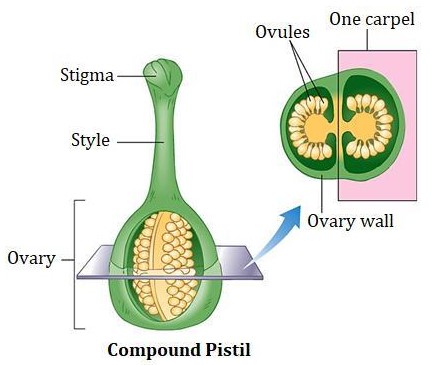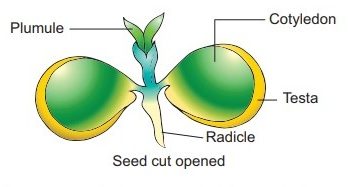The terms ‘carpel’ and ‘pistil’ are fundamental in the study of flowering plants, specifically in understanding their reproductive parts. Although related, carpels and pistils are distinct structures with specific roles. A carpel is the basic unit of the flower’s female part, consisting of an ovary, style, and stigma. A pistil, on the other hand, can be a single carpel or a group of fused carpels functioning as the seed-bearing component. Distinguishing between these two is crucial for a clear understanding of plant reproduction mechanisms.
Table of Contents
7 Differences Between Carpel and Pistil in Tabular Format
| Aspect | Carpel | Pistil | |
|---|---|---|---|
| 1 | Definition | A carpel is the individual female reproductive unit of a flower, made up of an ovary, style, and stigma. | A pistil may refer to a single carpel or a group of fused carpels, and serves as the ovule or seed-bearing part of a flower. |
| 2 | Composition | Comprises three main parts- ovary, stigma, and style. | Can be composed of a single carpel or multiple fused carpels. |
| 3 | Function in Reproduction | Directly involved in producing egg cells, undergoing fertilisation, and subsequently in seed production. | Does not produce egg cells or undergo fertilisation by itself; these processes occur within the carpels that make up the pistil. |
| 4 | Seed Production | Directly involved in seed production following fertilisation. | As a composite structure, it does not directly produce seeds; seed production occurs within its constituent carpels. |
| 5 | Fertilisation | The site of fertilisation, leading to the development of seeds. | Supports the process of fertilisation but is not the direct site of fertilisation. |
| 6 | Role in the Flower | Specifically tied to egg production, pollen reception, and seed development. | Serves as the female reproductive structure, encompassing the overall function of reproduction in the flower. |
| 7 | Counting and Identification | The number of styles can help determine the number of carpels. | The number of ovaries can help determine the number of pistils. |
Difference Between Carpel and Pistil Explained in Details
Difference Between Carpel and Pistil in terms of Structure and Definition-
- Carpel– It is the individual female reproductive structure within a flower, specifically designed to function in the process of reproduction. Each carpel consists of three main parts- the ovary at the base, the style extending from the ovary, and the stigma at the top. The carpel is crucial for the development of egg cells, reception of pollen, and subsequent seed production.
- Pistil- This term refers to the structure within the flower that can be a single carpel or a collection of several carpels fused together. As the seed-bearing part of the flower, the pistil is central to the flower’s reproductive system. When multiple carpels are fused, they form a single pistil, which then functions as the composite female reproductive organ of the flower.
Also Check – Flower- Structure, Parts, and Functions
Difference Between Carpel and Pistil in terms of Composition-
- Carpel- The composition is quite straightforward, with each carpel having an ovary, stigma, and style. These parts are integral to its function in reproduction, from the development of ovules within the ovary to the reception of pollen on the stigma.
- Pistil– The complexity in the composition of a pistil arises when it is formed from multiple fused carpels. In such cases, the pistil inherits the collective features of its constituent carpels, including multiple ovaries, stigmas, and styles, depending on the degree of fusion and the number of carpels involved.
Difference Between Carpel and Pistil in terms of Function in Reproduction-
- Carpel- Each carpel is directly involved in the plant’s reproductive process. It produces egg cells within the ovary, receives pollen on the stigma, and facilitates the passage of pollen tubes down the style to the ovary for fertilisation. Following fertilisation, the ovary develops into a fruit containing seeds.
- Pistil- While the pistil is also central to the flower’s reproduction, its role is more about the collective function of its constituent carpels. It does not produce egg cells or undergo fertilisation itself; instead, these processes occur within each carpel that forms part of the pistil.
Also Check – Sexual Reproduction in Flowering Plants
Difference Between Carpel and Pistil in terms of Seed Production-
- Carpel- Seed production is a direct function of the carpel. Following fertilisation, the ovule within the ovary develops into a seed. This process is crucial for the propagation of the plant species.
- Pistil- Although the pistil is involved in the broader reproductive structure, seed production occurs within the ovaries of the carpels that comprise the pistil. The pistil facilitates this process but is not the direct site of seed development.
Difference Between Carpel and Pistil in terms of Fertilisation-
- Carpel- Fertilisation occurs within the carpel, with the pollen tube delivering sperm cells to the ovule in the ovary. This is where the sperm and egg cells unite, leading to the development of seeds.
- Pistil- The pistil provides the structural framework for fertilisation to occur within its carpels. While it supports the process by positioning the carpels optimally for pollen reception, the actual fertilisation happens within the individual carpels.
Difference Between Carpel and Pistil in terms of Role in the Flower-
- Carpel- The carpel’s role is narrowly defined by its direct involvement in producing egg cells, receiving pollen, and developing seeds. Its structure and function are finely tuned to these tasks.
- Pistil- As potentially a composite structure, the pistil’s role encompasses the collective reproductive capabilities of the flower. It symbolises the female reproductive system in its entirety, comprising one or more carpels.
Difference Between Carpel and Pistil in terms of Counting and Identification-
- Carpel- The number of styles in a flower can be a clear indicator of the number of carpels present. Each style typically corresponds to one carpel, making it easier to count and identify them.
- Pistil- In contrast, the number of ovaries can help distinguish the number of pistils, especially in cases where the pistils are formed from fused carpels. This can be a bit more complex to determine, as the fusion of carpels can create a single pistil with multiple ovaries.
Frequently asked questions on Difference Between Carpel and Pistil
Define a carpel and a pistil.
- Answer- A carpel is the individual female reproductive unit within a flower, consisting of an ovary, style, and stigma. A pistil may refer to a single carpel or a group of fused carpels, serving as the seed-bearing part of a flower.
What are the main components of a carpel?
- Answer- The main components of a carpel are the ovary, style, and stigma.
How does a pistil differ from a carpel in terms of composition?
- Answer- A pistil can be composed of a single carpel or multiple carpels fused together, whereas a carpel is a singular structure with three parts- the ovary, stigma, and style.
Explain the role of a carpel in the reproductive process of a flower.
- Answer- The carpel plays a direct role in the flower’s reproductive process by producing egg cells, facilitating the reception of pollen on the stigma, guiding the pollen tube growth through the style to the ovary during fertilisation, and subsequently participating in seed production.
Why is the pistil not directly involved in fertilisation?
- Answer- The pistil, being an aggregate structure of one or more carpels, supports the overall reproductive process but does not directly undergo fertilisation itself. Fertilisation occurs within the individual carpels that comprise the pistil.
How can the number of carpels and pistils in a flower be determined?
- Answer- The number of carpels in a flower can be determined by counting the styles, whereas the number of pistils can be identified by the number of ovaries present.
Describe the significance of seed production in relation to carpels and pistils.
- Answer- Seed production is a function of the carpel, which develops seeds following fertilisation. While the pistil, as a collective structure of carpels, is part of the broader reproductive organ within which seeds are produced, it is the individual carpels within the pistil that are directly responsible for seed development.
What is the importance of understanding the differences between carpels and pistils in botany?
- Answer- Understanding the differences between carpels and pistils is crucial for botanical classification, studying plant reproductive systems, and understanding the diversity and evolution of flowering plants.



